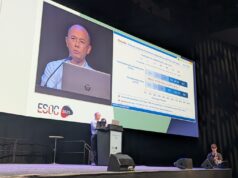
A collaboration analysing several major clinical trials has found that endovascular therapy (EVT) plus intravenous thrombolysis (IVT) is likely to be superior to EVT alone—also known as direct EVT—in the majority of ischaemic stroke patients, but that one of the most important factors in determining this is time from symptom onset to treatment.
In light of this, Johannes Kaesmacher (Bern University Hospital, Bern, Switzerland)—who presented findings from the IRIS collaboration at the European Stroke Organisation Conference (ESOC; 24–26 May, Munich, Germany)—commented that the decision to administer IVT before EVT “should take into account time-dependent treatment effects, rather than the overall effect” of thrombolytics.
The IRIS collaboration involved a pooled analysis of the six major randomised controlled trials (RCTs) that have compared direct EVT and EVT plus IVT to date: DEVT, DIRECT-MT, DIRECT-SAFE, MR CLEAN-NO IV, SKIP and SWIFT-DIRECT. These trials evaluated whether direct EVT has either a superior or non-inferior impact on functional outcomes, as compared to ‘bridging thrombolysis’ prior to EVT, in patients with an acute ischaemic stroke caused by an anterior circulation large vessel occlusion.
The IRIS investigators conducted a meta-analysis of individual participant data from these trials—which included a total of 2,313 patients—hypothesising that there would be a “significant treatment-effect heterogeneity” between the administration of an intravenous thrombolytic drug (alteplase or tenecteplase) prior to EVT and delays in treatment. More specifically, they anticipated that patients with shorter intervals from onset to randomisation would benefit from IVT, while patients with longer intervals would not.
To this end, Kaesmacher and colleagues deployed an ordinal, mixed-method model regression analysis, adjusted for relevant baseline characteristics, with 90-day ordinal shifts in modified Rankin scale (mRS) scores being the primary outcome.
The investigators’ initial hypothesis was ultimately fulfilled in the results of their primary outcome analysis, as a higher proportion of the 928 patients with an onset-to-expected-IVT time <134 minutes achieved an excellent functional outcome (mRS 0–2) when treated with EVT plus IVT, as compared to those treated with direct EVT. However, the same improvement in outcomes was not seen in the 1,385 patients with an onset-to-expected-IVT time ≥134 minutes, as EVT plus IVT and direct EVT led to broadly comparable benefits in this later time window.
A similar yet less-pronounced trend towards greater benefit with EVT plus IVT was observed regarding good functional outcomes (mRS 0–3) in the <134-minute group—but, again, not in the ≥134-minute group—as well.
These findings led Kaesmacher et al to conclude that, up to two hours and 15 minutes, they were able to establish the superiority of IVT prior to EVT versus EVT alone, but that the same superiority trend could not be established beyond this timepoint. In his presentation, Kaesmacher noted that these findings from IRIS were borne out by the “only available data”, thus far, on randomised comparisons of EVT with and without IVT.
Modelling IVT benefits
Another first-time data presentation at ESOC 2023 saw Jasper Daems (Erasmus University Medical Center, Rotterdam, The Netherlands) deliver results with a clinical model for predicting individualised treatment benefits of IVT before EVT—also derived from IRIS’ ischaemic stroke patient population.
Against a similar backdrop to the one presented by Kaesmacher earlier that day—the fact that, overall, direct EVT has been shown not to be non-inferior, nor superior, to the current standard of care (EVT plus IVT)—Daems and his colleagues set out to capture potential between-patient heterogeneity in benefit and support clinical decision-making with their model, not only using time to treatment but also other available patient characteristics. Outlining the relevance of an individualised approach to IVT treatments, the speaker added that “the average patient is unlikely to be in front of you”.
Daems et al’s study saw patients treated with tenecteplase or urokinase excluded from the model, meaning all EVT-plus-IVT patients in their analysis received intravenous alteplase, and resulting in a patient population of 2,284 (median age=71 years) derived from the IRIS database. The researchers found that differences in predicted outcomes between direct EVT and EVT plus IVT were “generally small”, and favoured the latter for “most patients”.
However, Daems also stated that the expected benefits of both treatment approaches vary between individual cases, and that certain patients—mostly those presenting later than 3.5 hours from symptom onset—were predicted to experience potential benefits from direct EVT. The speaker further noted that a greater likelihood of achieving mRS 0–2, equivalent to >3%, was predicted in patients who received EVT plus IVT <2 hours from symptom onset.
Concluding his talk, Daems told the ESOC audience that the model discussed may be able to identify patients in whom a larger-than-average benefit, no benefit, or even harm, can be expected if IVT is given prior to EVT. Additionally, he noted that, after further validation, the model could hold the capacity to inform and support “personalised treatment decisions” regarding IVT administration before EVT in ischaemic stroke patients.










